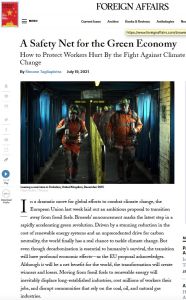Join getAbstract to access the summary!

Join getAbstract to access the summary!
Simone Tagliapietra
A Safety Net for the Green Economy
How to Protect Workers Hurt By the Fight Against Climate Change
Foreign Affairs, 2021
What's inside?
Governments need to reckon with the economic impacts of climate change on workers and their communities.
Recommendation
The price of renewable energy has decreased markedly, something that should help government efforts to address climate change. But the state also has the responsibility to help those who will be displaced by such efforts. Professor Simone Tagliapietra draws sobering parallels between these imperatives and past failures in dealing with globalization’s effects. Yet he sees reason for optimism in fiscal plans to turn carbon emissions into carbon dividends that could support disadvantaged individuals and communities, while at the same time improving the environment and creating jobs.
Summary
About the Author
Simone Tagliapietra is a senior fellow at Bruegel and an adjunct professor at the Catholic University of the Sacred Heart in Milan.




















Comment on this summary